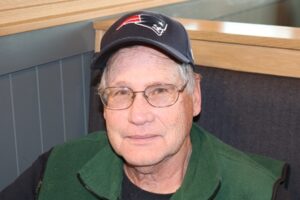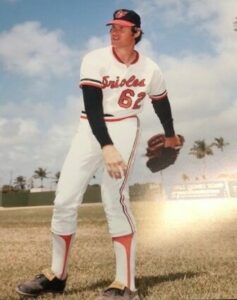Pitched for several teams in spite of serious eye disease

Photo/Jane Keller Gordon
By Jane Keller Gordon, Assistant Editor
Berlin – During his senior year in high school, baseball player Paul Mitchell struck out at bat twice in a row.
“It didn’t make any sense,” he said. “I could throw harder than anyone and was a good hitter.”
His coach told his parents that something was wrong. It turned out that Mitchell, who went on to play professional baseball for 10 years, had a rare eye disease – Keratoconus. His corneas were becoming shaped like a cone rather than a dome. He was losing his visual acuity.
As a child, Mitchell spent long hours playing all kinds of ball — baseball, football and basketball — at Worcester’s Vernon Hill Park, which was near his home. He went on to play Little League and Babe Ruth baseball. Mitchell was recruited by Dee Rowe, the renowned athletic director of Worcester Academy, to play sports at the private school.
Mitchell’s batting problems in high school were the result of blurry vision, which set in after a week-long high fever.
Fortunately, Dr. G. Burtt Holmes, a pioneer of the contact lens, practiced in Worcester.
“I saw Dr. Holmes, and he gave me glasses, and then contact lenses. The contacts kept on falling out. He’d give me more, but eventually he sent me to Boston and New York to see specialists. It took several months to figure out what was wrong,” said Mitchell.
The solution turned out to be scleral lenses, which covered the whole eye.
“They were very uncomfortable, but they helped,” he said.
Mitchell’s eyesight wasn’t perfect, but his hands were big and strong.
He was drafted by the Pittsburgh Pirates out of high school.
“My parents and I decided that I would attend Old Dominion University in Norfolk, Virginia, on a baseball scholarship instead,” he said.
At Old Dominion, Mitchell concentrated on pitching. During those summers, he pitched for the Falmouth Commodores, a collegiate team in the Cape Cod League.
“I was the most valuable pitcher two of the three years that I was there,” he said.
After three years at Old Dominion, in 1971, Mitchell was drafted in the first round by the Baltimore Orioles. He spent one year to their AA team in Asheville, and then two years in AAA in Rochester, New York.
During this time, Mitchell completed his degree from Old Dominion in 1973, and married his a classmate, Liz, in 1974.
In 1975, Mitchell was called up to the Majors. Much to his excitement and dismay, he played his first MLB game at Fenway Park, pitching against Carl Yastrzemski, Carlton Fisk and other great Red Sox players. The Orioles won that game, 12-8. Mitchell spent a year with the Orioles, ending with a 3-0 record.
In 1976, along with Mike Torres and Don Baylor, Mitchell was traded to the Oakland As in exchange for several players including Reggie Jackson and Ken Holtzman.
He spent two-and-a-half years with the Oakland As.
“We had a very good team. We came in second in the American League West. But with the loss of free agency, we became a less productive team. I was drafted by the Seattle Mariners, an expansion team. That team struggled, we didn’t have enough quality,” said Mitchell.
“I played two years in Seattle. Then I was traded to Milwaukee Brewers. I was there for a year-and-a-half. I pitched 5-5 for the Brewers, including two shutouts. Unfortunately, the Milwaukee Brewers had three high-priced players who they needed to pay for, so I became expendable. I was under contract so I couldn’t go to another team.”
That was the end of baseball for Mitchell. He came back to Worcester, and never pitched again. After trying a few jobs, he joined his family’s window cleaning business, Mitchell and Sons, which was founded by his grandfather in 1914.
He has had both of his corneas replaced with transplants, giving him good, but not perfect, vision.
Mitchell and his wife raised his son and daughter in Berlin. He now has four grandchildren. He sold the family business in 2017 due to family circumstances.
As for his baseball career, Mitchell said, “When I got released from Milwaukee Brewers, it was a shock to my system not be at the ballpark every afternoon. But 10 years was enough. I wanted to be there to raise my kids, and I did.”

Photo/Paul Mitchell












